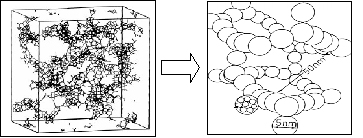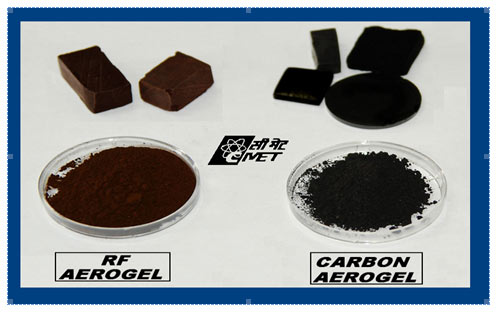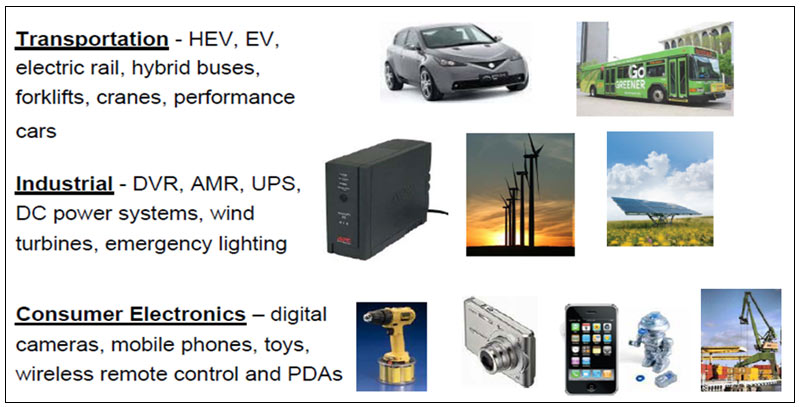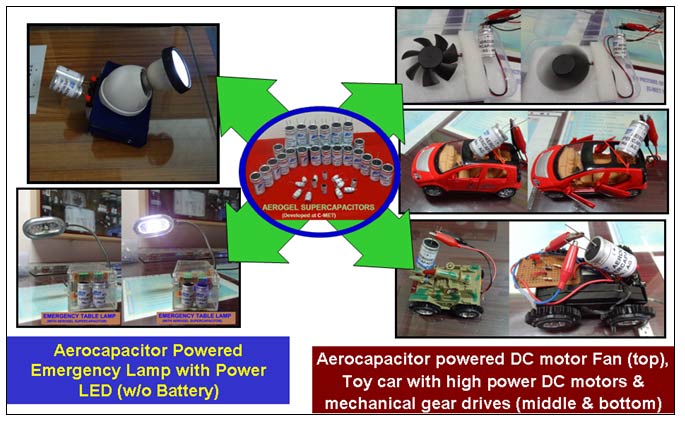Aerogels: A novel material with high application potentials
Aerogels are newest class of novel materials having open cell monolithic structures, in which nanometer sized particles are bonded in 3-dimenssional network of highly porous structure. They are the ultra low density materials derived from various gels and exhibited unique thermal, optical, electrical, catalytic and gas sorption properties due to their peculiar microstructural features. Aerogels find enormous application potentials by virtue of its light weight, high specific surface area, tunable pore sizes, and high open porosities. Some of the novel applications of aerogels are super thermal insulation, electrode materials for energy storage devices (viz. Supercapacitor, Fuel cell, hybrid battery, Li-ion battery, etc.), membrane filtration, media for gas storage (H2, methane, etc.), light weight composite structuring materials, etc.

C-MET is engaged in development of aerogels for last few years and developed aerogels of different materials for specific applications, say, carbon aerogel for aerogel supercapacitor, metal doped aerogel compositions for hydrogen storage, silica aerogels for thermal insulation applications, etc. C-MET is now equipped with the facilities for preparation of Aerogel of different materials and its processing techniques for specific applications.
CARBON AEROGELS
Carbon aerogels are special class of porous monolithic solids, in which nano-meter sized carbon particles are inter-linked in 3D network. Organic gels upon implementation of suitable drying technique followed by carbonization lead to the formation of corresponding Carbon aerogels. Because of high specific surface area, high open porosity with tunable pore sizes and light weight, Carbon aerogels are found to be the most idea choice as electrode materials for variety of applications, such as electrode for EDLC, PEM based fuel cell, Li-ion batteries, etc. C-MET has developed the indigenous technique of making wide range of carbon aerogel compositions having the superior specifications for hydrogen storage and supercapacitor applications.

The characteristics & specifications of Carbon aerogels developed at CMET are
Density: 0.3-0.9 g/cm3
Specific Surface area: 500-2380 m2/g
Average Pore Diameter: 3-5 nm
Porosity: 50-80%
AEROGEL SUPERCAPACITOR
Supercapacitors are efficient electrical energy storage devices, in which large amount of electric charges are stored within small volume. Supercapacitors are also known as ultracapacitors (UC) or Electric Double Layer Capacitors (EDLC), in which two oppositely charged electric double layers, are formed at the electrode-electrolyte interface under the influence of an electric field. When the supercapacitors are comprised with carbon aerogel, they are referred as Aerogel Supercapacitors or Aerocapacitors and a small aerocapacitor can store large amount of electrical energy (10,000 times more than that of the conventional capacitors). Aerogel Supercapacitors exhibited several fascinating characteristics, such as fast charge-discharge, with high power delivery capacity & moderate energy density, ultra low ESR, longer capacitor life and wide working temperatures and because of unique electrical performances, Aerogel Supercapacitors are the ideal choice for many applications, say transportation, industrial electronics and

consumer electronics including high resolution camera flashes, mobile phone, electronic toys, xEV/HEV, engine starting, cold cranking (IC engine), regenerative breaking, power supplies, etc. that requiring fast charge/discharge and high powers for its performances.
Supercapacitor based storage system will definitely go a long way in supplementing/ replacing some of the existing conventional devices like different battery based systems. Further, the advantages of supercapacitors open up new applications as well, especially the effective harvesting/storage of solar /wind energies and hence its demands are also increasing day-by-day.

Development of materials for energy storage is one of the thrust areas of C-MET and the Aerogel team of C-MET has developed Aerogel Supercapacitors of different sizes/values for specific electronic applications. Carbon aerogel based Supercapacitors developed at CMET exhibited the following characteristics
Characteristics & features of Aerogel supercapacitors developed at C-MET
Cell capacitance range: 1 ~ 35 F
Working voltage range: 2.5 – 3.3 V
Charge-discharge characteristics: fully reversible.
Low ESR & wide operating temperatures (-25°C ~+80°C)
Apart from the basic development, C-MET is also dedicated in exploring utilization of Supercapacitors for various end applications. Aerogel Team of C-MET has demonstrated the use of supercapacitors for variety end applications, including designing of suitable electronic circuit for specific applications. The team has designed and demonstrated supercapacitor applications in several cases, such as (a) Supercapacitor powered bicycle tail-light for preventing safety in rural areas, (b) running high power DC motors with Fan used for system cooling, (c) running electronic toys (cars) having mechanical geared high power DC motor for toys functioning, (d) fully supercapacitor powered Fast-chargeable Emergency light with Power LED.

The development and demonstration of technology for production of carbon aerogel and aerogel supercapacitors in pilot scale is in progress.
Other Aerogels:
SILICA AEROGELS
Being the lightest material with ultra-low thermal conductivity, silica aerogels can be used as suitable candidates for TPS (thermal protection system) in space vehicles as well as in other insulation purposes such as refrigerators, industrial insulations etc. C-MET has also developed low density and high surface area silica aerogel of different sizes & shapes for the TPS applications.

Specification of Silica Aerogel developed at C-MET :
Bulk density: 0.10 – 0.30 g/cm3;
Specific surface area: 700-1000 m2/g
Average pore diameters: 7-20 nm
Average porosity: 95-97%
TITANIA AEROGELS
Dye sensitized solar cell (DSSC) have attracted much attention as they offer the possibility of extremely inexpensive and efficient solar energy conversion. DSSC which converts light energy into electrical energy consists of nanocrystalline semiconductor based photo anode. The performance of DSSC mainly depends on the dye uptake by photo anode which is directly related with the surface area and porosity of the photoanode material. Generally crystalline titania of surface area of ~ 50 m2/g are used as DSSC photoanode, however, C-MET has undertaken the development of titania aerogel for the DSSC photoanode, in nano-sized porous crystalline titania aerogel of surface areas in the range of 150-200 m2/g have been achieved. Utilization of this titania aerogel in DSSC photoanode and its performance evaluation are in progress.


